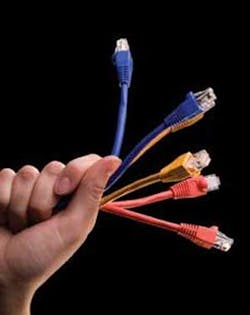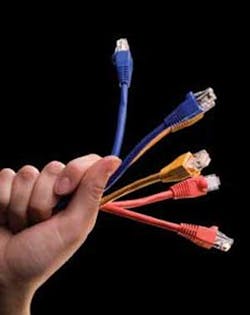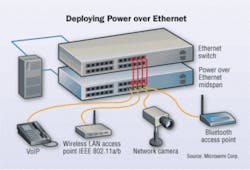PoE+: Squeezing the most out of your cabling
The right mix of midspan and endspan products, as well as high- and low-power devices, can maximize energy efficiency.
The latest 802.3at draft 4.2 Power over Ethernet (PoE) Plus specifications from the Institute of Electrical and Electronics Engineers (IEEE; www.ieee.org) offer new opportunities for cabling professionals to significantly improve networking infrastructure cost and energy efficiency. High-power PoE will help squeeze even more usefulness out of Category 5e and above cabling infrastructure while expanding PoE’s benefits to a much broader range of applications and powered devices (PDs).
Few technologies meet today’s dual goals of energy efficiency and cost management better than the latest high-power PoE technology. And with the advent of enterprise-grade PoE solutions, it can be more convenient than ever to take advantage of high-power PoE’s promise.
The original IEEE 802.3af-2003 PoE standard safely delivered up to 12.95 watts at a nominal 48 volts of direct current (DC) over Category 3 (Class C) and above structured cabling. It enabled power delivery to PDs, ranging from Internet Protocol (IP)-based phones and security cameras to wireless access points, radio-frequency identification (RFID) tag readers, and building access-control equipment.
In 2004, the IEEE began exploring opportunities to enable power sourcing equipment (PSE) to deliver more power to a broader range of PDs, including laptop computers, thin clients, pan/tilt/zoom (PTZ) cameras, and IP television. PoE energy-delivery efficiency is surpassing that of traditional wall-adapter solutions in some applications, and a new, enterprise-grade system approach is making it easier to deploy and manage the power infrastructure.
New current, voltage levels
To support the increased powering requirements of a broader range of PDs, today’s draft PoE Plus specifications increase the current, voltage, and wattage delivered over legacy (Category 5/Class D: 1995 or better) structured cabling. New installations are required to meet or exceed Category 5e/Class D: 2002 requirements.
Category 5e and above cables have lower impedance than previous-generation cables, which reduces dissipation and enables more power to be transmitted over more conductors. Category 5 cables support the new high-power PoE standard’s higher maximum current of 600 mA–nearly double the earlier standard.
Some claim that high-power PoE will endanger network operational safety at this current level unless cabling professionals control heating problems by adjusting cable runs and carefully choosing cabling systems. This is not true. The IEEE P802.3at task force has worked with the TIA and ISO cabling standards development bodies to characterize the current-carrying capacity of various categories of twisted-pair cables. The TIA, in corroboration with ISO, developed profiles of temperature rise versus applied current per pair for Category 5e, 6, and 6A cables configured in a 100-cable bundle with all pairs energized. Neither the TIA nor the ISO have uncovered any issues with deploying high-power PoE using Category 5e cabling with 600 mA current levels.
In addition to higher current, the new high-power standard also increases minimum voltage from 44 to 50 volts to improve efficiency, as higher voltages require lower currents to achieve any given power level. Available power is 16% higher than before, and maximum wattage has been nearly doubled to 25.5 watts.
It is possible to achieve approximately 60 watts per port by using all four pairs of a Category 5 Ethernet cable, without infringing the IEEE 802.3at draft 4.2. With high-power PoE’s 600 mA current level, 51 watts can be delivered, compared to 42 watts for 2-pair solutions. This same 4-pair configuration can, alternatively, be used to power 2-pair devices with a lower 30 watts of power per port, while dissipating up to half the power and consuming almost 15% less energy than 2-pair solutions. The savings from this approach can reach approximately $25 per year per PD, assuming energy costs of $0.10 per kilowatt hour (kWH).
Classification changes
High-power PoE also establishes a new power taxonomy for PDs and PSE. The high-power PD specification includes the earlier 1-Event Physical Layer Classification of the original standard for backward compatibility with the earlier 12.95-maximum wattage requirement. The same classification is used by the PSE to power up legacy PDs.
Additionally, there is now a 2-Event Physical Layer Classification and a Data Link Layer Classification. With the former, the PSE emits two classification pulses, and any high-power PD that requires more than 12.95 watts returns a Class 4 signature. With the latter, the PSE emits a single classification pulse and provides power to the PD, which then is able to begin communicating and negotiating the power with the PSE using a data-link-layer protocol, such as the Link Layer Discover Protocol (LLDP). The IEEE 802.3at draft 4.2 standard requires that PDs support both classification methods, while the PSE is only required to support one.
Along with the new high-power standards has come a new generation of enterprise-class PoE equipment that delivers higher levels of flexibility, scalability, energy efficiency, reliability, safety, and remote maintenance and management capabilities. Midspans offer a more-flexible option than PoE-capable switches, and are deployed between the switch and PDs without changing the existing infrastructure. Midspan ports can be added as needed, decoupling the power and data infrastructures for optimal scalability. Some single-port units include an interlocking feature for scaling the power infrastructure in 1-port increments as new PDs are added.
Powering options include AC, DC, or another midspan, and the midspans can use DC inputs with external power supplies to add power capacity or redundancy. The latest enterprise-class midspans also implement per-port power management to support green infrastructure initiatives, and are available with gigabit interfaces to support high-power gigabit phones, WiMAX transmitters, or 802.11n access points.
Eliminating power waste
Energy efficiency is one of the most important benefits of enterprise-class PoE. If poorly designed, the PoE infrastructure can be one of the data center’s most troublesome energy drains. Enterprise-class midspans solve this problem by reducing heat concentration and delivering only the required power as a green alternative to PoE switches. The latest enterprise-class units also leverage a distributed power architecture to eliminate power waste in a large power supply.
A 48-port switch with 800 watts of full power per port might use only 20 ports at once, and waste 80 watts of quiescent power. In high-power IEEE 802.3at applications, it’s rare for any single port to require full power. To solve this problem, enterprise-grade PoE midspans augment smaller, more-economical internal default power supplies with external power supplies for added power capacity or redundancy. This improves system efficiency and reduces cooling costs because smaller supplies require smaller and/or lower-speed fans. And because these midspans can back each other up, one or multiple additional power supplies are available for the highest-priority system ports. This also improves reliability and safety.
Reliability and safety are further improved by adhering to industry-standard configurations. Midspans promising more than the industry-standard wattage per port present standards-compliance problems, and anything delivering more than 100 watts per port poses safety dangers as well.
Enterprise-grade midspans should also have remote power-management capabilities, with support for IPv4 and IPv4/6 addressing as well as secure, SNMPv3 remote control. Simple and efficient remote PD monitoring and control become more important the larger and more complex the network to power PDs on and off, and to selectively shut down ports during the day. These capabilities can reduce power consumption by as much as 70%. The latest midspans accurately measure and actively adjust each device’s average power consumption.
Other enterprise-class remote management features include unit scheduling, uninterruptible power supply (UPS) power monitoring, and Web-based monitoring. These features enable malfunctioning devices to be remotely reset without a service call. Enterprise-class midspans enable centralized control of multi-site or multi-building installations, and they support capabilities such as immediate (e.g., E911) alert and response if IP phone status changes. When the midspan is integrated with a UPS system, the remote power-off/power-on capability also enables low-priority ports to be disconnected during power failures.
Deployment best practices
When choosing a PSE, it’s important to select a system with the full range of enterprise-class features, and a power supply with the highest possible voltage. This will reduce the current of any given PD load as well as the power dissipated inside the PSE. Selecting the right voltage can improve the efficiency of overall system conversion by as much as 5%.
Power dissipation inside the PSE is further reduced by selecting a PSE that implements the DC maintain-power signature-disconnect method, eliminating the need for a diode in series with each port. A PSE should also feature wire races with at least the minimum width recommended by the PSE IC manufacturer, and proper ventilation for the power dissipated by the circuit.
As mentioned earlier, multiple power supplies should feed the system as part of a distributed power architecture. With this approach, users pay only for the power they use, and have the option to incrementally add power supplies as needed, as well as to use remote management to rapidly disconnect ports in case of power-supply failure. Finally, PSEs should feature non-saturating pulse transformers that can withstand 600 mA of ongoing current, with at least 120 microH inductance.
When installations reach 250 ports or more, midspans can dramatically reduce a business’s total cost of ownership (TCO), including savings in purchase and installation costs from maintaining the existing switch, as well as the long-term cuts in outsourced IT and electrical labor and other installation, overhead, and maintenance costs. Midspans further improve TCO through increased productivity because of decreased device downtime.
In some cases, IT administrators may wish to combine midspans in some portions of the network with new PoE switches elsewhere. The latest high-power standards support a similar mix-and-match approach at the PD level, in which both low- and high-power terminals are used, depending on application requirements. Today’s hybrid PoE infrastructures are capable of supporting a rich mixture of PSEs and PDs.
Operational, energy savings
With the arrival of high-power IEEE 802.3at solutions, the industry is adopting new techniques and technologies to reduce power dissipation while enabling the intelligent, dynamic allocation of incremental additional primary and backup power. Cabling professionals and IT administrators can further optimize their networks’ and cabling infrastructures’ efficiency through the right choice of PoE deployment strategies, including a combination of PoE-capable switches and midspans, and the mixing of both low- and high-power PDs.
With the optimal power infrastructure in place, cabling professionals and the users they serve can realize significant TCO, capex, and operational savings while improving energy efficiency and deploying a number of productivity-boosting applications.
DANIEL FELDMAN is director of telecom products within Microsemi Corp.’s analog mixed-signal group (www.microsemi.com).
More Cable Installation & Maintenance Issue Articles


